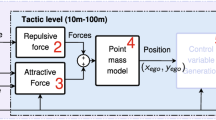Abstract
In this article, a collision avoidance scheme based on potential functions is proposed. The first part of the paper is intended to establish the equations of the dynamic model of the vehicle, potential attractive functions and nested saturation controller. In the second part, the repulsive scheme is developed. Along with the repulsive scheme, the controller constants are optimized, in order to perform a safer avoidance maneuver. The advantages of the proposed repulsive schemes compared with a conventional repulsive function are demonstrated by simulations.
Similar content being viewed by others
References
Maria Carmela De, G., Jadbabaie, A.: Formation control for a cooperative multy-agent system using decentralized navigation functions. In Proceedings of the 2006 American Control Conference, June 14-16 (2006)
Yi, L., Lee, H.-H.: Decentralized formation control and obstacle avoidance for multiple robots with nonholonomic constraint. In: Proceedings of the 2006 American Control Conference, pages 5596–5601, June 14-16 (2006)
Paul, T., Krogstad, T. R., Gravdahl, J. T.: Uav formation flight using 3d potential field. In: 16th Mediterranean Conference on Control and Automation, pp. 1240–1245, June 25-27 (2008)
Xue, D., Yao, J., Chen, G., Yu, Y.-L.: Formation control of networked multi-agent systems. IET Control Theory Appl. 4(10), 2168–2176 (2010)
Vadakkepat, P., Tan, K. C., Ming-Liang, W.: Evolutionary artificial potential fields and their application in real time robot path planning. In: Congress on Evolutionary Computation, Vol. 1, pp 256–263 (2000)
Valbuena, L., Tanner, H. G.: Hybrid potential field based control of differential drive mobile robots. J. Intell. Robot. Syst. 68(3-4), 307–322 (2012)
Cruz, G. C. S., Encarnação, P.M.M.: Obstacle avoidance for unmanned aerial vehicles. J. Intell. Robot. Syst. 65(1-4), 203–217 (2012)
Jean-Claude, L.: Robot Motion Planning. Kluwer Academic Publishers, MA, USA (1991)
Tang, Q., Yi, S., Chengyu, H., Zeng, J.: Multi-swarm cooperation optimization for multi-modal functions in repulsive potential field. In: Fourth International Workshop on Advanced Computational Intelligence, pp. 70–74, Oct. 19-21 (2011)
Leng-Feng, L.: Decentralized motion planning with an artificial potential framework (apf) for cooperative payload transport by multi-robot collectives. Master?s thesis, Faculty of the Graduate School of the State University of New York (2004)
Ge, S. S., Cui, Y. J.: New potential functions for mobile robot path planning. IEEE Trans. Robot. Autom. 16(5), 615–620 (2000)
Shi, P., Zhao, Y.: Global path planning for mobile robot based on improved artificial potential function. In International Conference on Automation and Logistics, pp 1900–1904 (2009)
Jia, Q., Wang, X.: An improved potential field method for path planning. In Control and Decision Conference (CCDC), 2010 Chinese, pp 2265–2270 (2010)
Kim, J. O., Khosla, P.: Real-time obstacle avoidance using harmonic potential functions. In IEEE Conference on Robotics and Automation, pp 790–796 (1991)
Ahmad, A.: Masoud. A harmonic potential approach for simultaneous planning and control of a generic uav platform. J. Intell. Robot. Syst. 65(1-4), 153–173 (2012)
Castillo, P., Lozano, R., Dzul, A.: Stabilization of a mini rotorcraft having four rotors. IEEE Control Syst. Mag. 25(6), 45–55 (2005)
García, L., Dzul, A., Santibáñez, V., Llama, M.: Quad-rotors formation based on potential functions with obstacle avoidance. IET Control Theory Aplications 6 (12), 1787–1802 (2012)
Kim, D. H., Lee, H.-W., Shin, S., Suzuki, T.: Local path planning based on new repulsive potential functions with angle distributions. In Information Technology and Applications, 2005. ICITA 2005. Third Int. Conf. 2, 9–14 (2005)
Teel, A. R.: Global stabilization and restricted tracking for multiple integrators with bounded controls. Syst. Control Lett. 18, 165–171 (1992)
Johnson, E. N., Kannan, S. K.: Nested saturation with guaranteed real poles. In American Control Conference, pp. 497–502, jun 4-6 (2003)
Chen, C.-T., 3rd edition: Linear System Theory and Design, OUP USA (1998)
García-Delgado, L., Gómez-Fuentes, R., García-Juárez, A., Leal Cruz, A. L., Berman-Mendoza, D., Vera-Marquina, A., Rojas-Hernndez, A. G.: An approach for optimal goal position assignment in vehicle formations. J. Intell. Robot. Syst. 73, 665–677 (2014)
Author information
Authors and Affiliations
Corresponding author
Rights and permissions
About this article
Cite this article
García-Delgado, L.A., Noriega, J.R., Berman-Mendoza, D. et al. Repulsive Function in Potential Field Based Control with Algorithm for Safer Avoidance. J Intell Robot Syst 80, 59–70 (2015). https://doi.org/10.1007/s10846-014-0157-z
Received:
Accepted:
Published:
Issue Date:
DOI: https://doi.org/10.1007/s10846-014-0157-z



